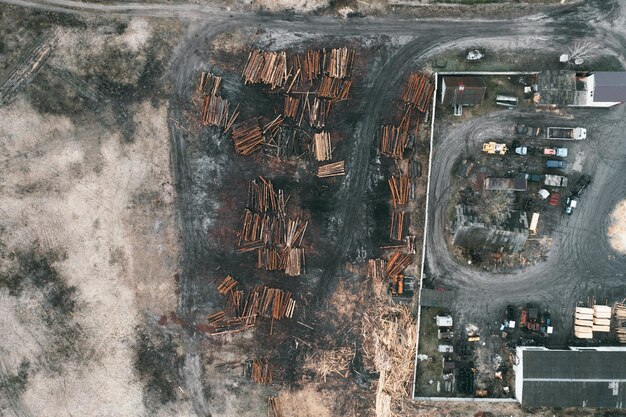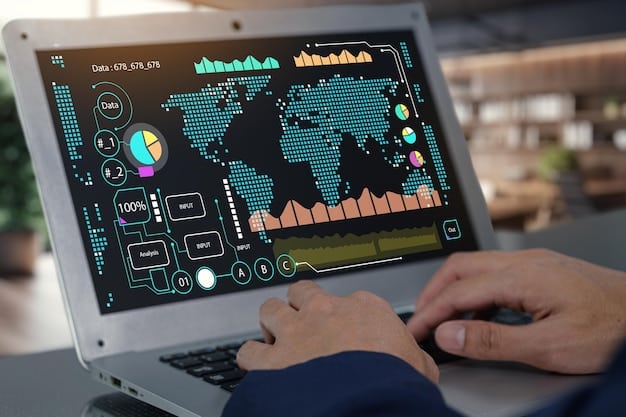Latest Innovations in US Humanitarian Aid Logistics & Supply Chains

The latest innovations in humanitarian aid logistics and supply chain management in the US include advanced technologies like drone delivery, blockchain for transparency, data analytics for predictive planning, and sustainable practices aimed at enhancing efficiency and resilience.
Humanitarian aid logistics and supply chain management are critical for delivering timely and effective assistance to populations affected by disasters and crises. The United States, with its vast resources and technological advancements, is at the forefront of innovation in this field. Understanding what are the latest innovations in humanitarian aid logistics and supply chain management in the US is essential for improving response efforts and saving lives.
Innovations in Supply Chain Visibility
Supply chain visibility is crucial in humanitarian aid to ensure resources reach the right people at the right time. Real-time tracking and monitoring systems have revolutionized how aid organizations manage their supply chains, providing unprecedented transparency and control.
Real-Time Tracking Systems
Real-time tracking systems allow aid organizations to monitor the location and condition of supplies as they move from warehouses to disaster zones. This technology provides accurate information on inventory levels, delivery times, and potential bottlenecks, enabling informed decision-making and proactive problem-solving.
These systems often integrate with GPS, RFID, and IoT devices, offering a comprehensive view of the entire supply chain. By leveraging this data, organizations can optimize routes, reduce delays, and minimize the risk of theft or spoilage.
Blockchain Technology for Transparency
Blockchain technology is emerging as a powerful tool for enhancing transparency and accountability in humanitarian aid supply chains. By creating a secure and immutable record of transactions, blockchain can help prevent fraud, corruption, and diversion of resources.
Each transaction, from procurement to delivery, is recorded on the blockchain, providing a transparent and auditable trail. This technology fosters trust among stakeholders, including donors, aid organizations, and affected communities.
- Enhanced transparency and accountability.
- Reduced risk of fraud and corruption.
- Improved coordination among stakeholders.
- Faster and more efficient delivery of aid.
In conclusion, innovations in supply chain visibility, such as real-time tracking systems and blockchain technology, are transforming humanitarian aid logistics in the US, by enabling better coordination, transparency, and efficiency.
Data Analytics for Predictive Planning
Predictive planning is essential for anticipating and preparing for humanitarian crises. Data analytics tools are enabling aid organizations to analyze historical data, identify trends, and forecast future needs, allowing them to allocate resources more effectively and respond proactively.
Predictive Modeling and Forecasting
Predictive modeling and forecasting techniques use statistical algorithms and machine learning to analyze historical data and predict future events. This allows aid organizations to anticipate potential disasters, assess risks, and plan accordingly.
By analyzing data on weather patterns, population density, socio-economic conditions, and past crises, organizations can develop accurate models that help them prepare for various scenarios and allocate resources to the most vulnerable areas.
Optimizing Resource Allocation
Data analytics can also be used to optimize resource allocation during a humanitarian crisis. By analyzing real-time data on needs, demand, and supply, organizations can make informed decisions about where to send resources and how to distribute them most effectively.
This involves using algorithms to match the right resources to the right people at the right time, minimizing waste, and maximizing impact. Data analytics also help identify gaps in service delivery and address them promptly.

The utilization of data analytics for predictive planning allows for enhanced preparation and response, enabling aid organizations to save time, resources, and ultimately, lives.
Drone Technology for Rapid Assessment and Delivery
Drone technology has emerged as a game-changer in humanitarian aid, providing rapid assessment capabilities and enabling the delivery of essential supplies to remote and inaccessible areas. Drones can quickly survey disaster zones, assess damage, and identify the most pressing needs.
Aerial Damage Assessment
Drones equipped with high-resolution cameras and sensors can capture aerial images and videos of disaster-stricken areas, providing valuable information on the extent of the damage. This information can be used to assess the impact of the disaster, identify areas that require immediate assistance, and plan the most effective response strategy.
Aerial damage assessment using drones is faster, safer, and more cost-effective than traditional methods, such as manual surveys or manned aircraft. Drones can quickly cover large areas, providing real-time information that is essential for effective disaster response.
Last-Mile Delivery Solutions
Drones can also be used to deliver essential supplies, such as medicines, food, and water, to remote and inaccessible areas. This is particularly useful in situations where roads are damaged or blocked, making it difficult to reach affected communities by traditional means.
Drone delivery can significantly reduce the time it takes to reach those in need, potentially saving lives. It also eliminates the need for aid workers to travel to hazardous areas, minimizing the risk of injury or death.
- Rapid damage assessment.
- Delivery of essential supplies to remote areas.
- Reduced response times.
- Improved safety for aid workers.
In summary, drone technology offers unparalleled advantages for rapid assessment and last-mile delivery, making it an indispensable tool in modern humanitarian aid logistics.
Sustainable and Eco-Friendly Practices
Sustainable and eco-friendly practices are becoming increasingly important in humanitarian aid logistics. Organizations are adopting green supply chain management principles to minimize their environmental impact and promote long-term sustainability.
Green Supply Chain Management
Green supply chain management involves integrating environmental considerations into all aspects of the supply chain, from procurement to distribution. This includes sourcing sustainable materials, reducing waste, minimizing emissions, and promoting energy efficiency.
By adopting green supply chain management practices, aid organizations can reduce their carbon footprint, conserve resources, and promote environmental stewardship. This is not only good for the environment but also enhances the credibility and reputation of the organizations.
Waste Reduction and Recycling Initiatives
Waste reduction and recycling initiatives are also essential components of sustainable humanitarian aid logistics. Aid organizations are implementing strategies to minimize waste generation, promote reuse and recycling, and properly dispose of waste materials.
This includes using durable and reusable packaging, reducing food waste, and recycling materials such as paper, plastic, and metal. Organizations are also partnering with local communities to establish waste management programs that create jobs and promote environmental sustainability.

Prioritizing sustainable practices in humanitarian aid logistics ensures responsible resource management and minimal environmental impact, aligning with global sustainability goals.
Cross-Sector Collaboration and Partnerships
Cross-sector collaboration and partnerships are vital for effective humanitarian aid logistics. By working together, government agencies, non-profit organizations, and private sector companies can leverage their respective strengths and resources to improve response efforts.
Public-Private Partnerships
Public-private partnerships (PPPs) involve collaboration between government agencies and private sector companies to deliver humanitarian aid. These partnerships can leverage the expertise, resources, and innovation of both sectors to improve efficiency and effectiveness.
For example, government agencies may provide funding, infrastructure, and regulatory support, while private sector companies may provide logistics services, technology solutions, and supply chain expertise. PPPs can also help to mobilize resources quickly and efficiently, ensuring that aid reaches those in need in a timely manner.
Collaboration with Local Communities
Collaboration with local communities is also essential for effective humanitarian aid logistics. Local communities have valuable knowledge and expertise about their own needs, resources, and vulnerabilities. By involving them in the planning and implementation of aid programs, organizations can ensure that their efforts are culturally appropriate, contextually relevant, and sustainable.
This includes engaging local leaders, community organizations, and volunteers in needs assessments, resource allocation, and distribution activities. Collaboration with local communities also helps to build trust and foster a sense of ownership, which is essential for long-term sustainability.
- Enhanced efficiency and effectiveness.
- Improved resource mobilization.
- Culturally appropriate and contextually relevant aid.
- Increased community ownership and sustainability.
In conclusion, fostering collaborations and partnerships across different sectors is crucial for a coordinated and effective humanitarian response.
Technology Integration and Automation
Technology integration and automation are transforming humanitarian aid logistics by streamlining processes, improving efficiency, and reducing costs. From automated warehouses to AI-powered decision support systems, technology is enabling aid organizations to respond more quickly and effectively to crises.
Automated Warehouses and Inventory Management
Automated warehouses and inventory management systems use robots, sensors, and software to streamline the storage, retrieval, and distribution of supplies. This reduces the need for manual labor, increases efficiency, and minimizes the risk of errors.
Automated warehouses can also optimize inventory levels, ensuring that supplies are available when needed but not stored unnecessarily. This helps to reduce waste, minimize costs, and improve the overall efficiency of the supply chain.
AI-Powered Decision Support Systems
AI-powered decision support systems can analyze large amounts of data in real-time, providing aid organizations with insights and recommendations that help them make informed decisions. This includes identifying the most pressing needs, allocating resources effectively, and optimizing delivery routes.
AI can also be used to predict future events, such as outbreaks of disease or natural disasters, allowing organizations to prepare proactively and respond more effectively. These systems enhance decision-making and resource allocation.
Adopting technology and automation in logistics ensures a more streamlined, efficient, and data-driven approach to humanitarian aid, ultimately improving response times and outcomes.
| Key Point | Brief Description |
|---|---|
| 🛰️ Real-Time Tracking | Monitoring supplies with GPS and RFID for transparency. |
| 📊 Data Analytics | Using predictive models to forecast needs and optimize resource allocation. |
| 🦺 Drone Technology | Employing drones for rapid damage assessment and last-mile delivery. |
| 🤝 Cross-Sector Collaboration | Fostering partnerships to leverage strengths and improve response. |
Frequently Asked Questions
▼
Supply chain visibility refers to the ability to track and monitor the movement of goods and resources throughout the supply chain, from origin to destination. It ensures transparency and accountability.
▼
Drones equipped with cameras and sensors can quickly survey disaster-stricken areas, capturing aerial images and videos that provide valuable information on the extent of the damage.
▼
Green supply chain management involves integrating environmental considerations into all aspects of the supply chain, from procurement to distribution, to minimize environmental impact.
▼
Cross-sector collaboration allows government agencies, non-profits, and private companies to leverage their strengths and resources, improving the efficiency and effectiveness of aid delivery.
▼
AI-powered systems analyze data in real-time, providing insights and recommendations for decision-making, resource allocation, and route optimization, improving overall efficiency and response.
Conclusion
The latest innovations in humanitarian aid logistics and supply chain management in the US are revolutionizing how aid organizations respond to crises. By embracing advanced technologies, sustainable practices, and collaborative partnerships, these organizations are improving efficiency, transparency, and effectiveness, ensuring that aid reaches those in need in a timely and impactful manner.





